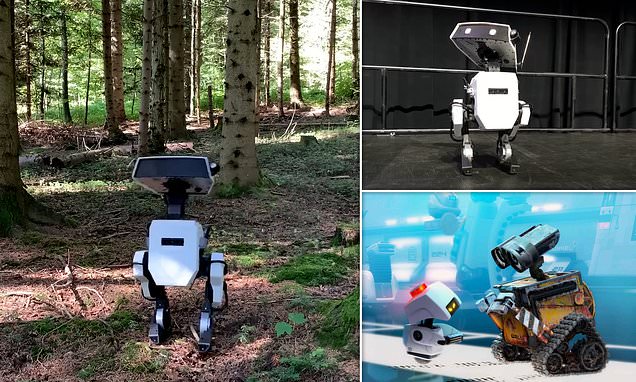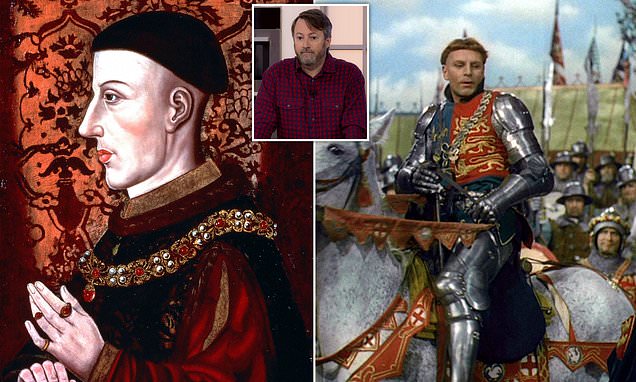The real-life Wall-E! Watch Disney’s adorable two-legged robot dance, strut and follow people around
- The robot is able to walk over various terrains and keep its balance
- Its engineers hope to use the same techniques to accelerate future designs
At first glance at this video, you’d be forgiven for mistaking it as a clip from Wall-E.
But the robot depicted in the footage isn’t science fiction – it’s very much real.
In a video posted by Walt Disney Imagineering, a newly designed bipedal robot walks, struts, dances, and emotes in an impressive display of engineering prowess.
The bot also shows off its human interaction skills as it reacts to those around it and even walks behind two children pulling it on a lead.
With its expressive head and wiggly antenna, the unnamed robot has been designed to bring the creative designs of animators into the real world using machine learning.
In a video posted by Walt Disney Imagineering, a newly designed bipedal robot walks, struts, dances, and emotes in an impressive display of engineering prowess
READ MORE: Electric sheep? World’s most advanced humanoid robot reveals what she DREAMS about
Commenters on social media were amazed at the little robot’s lifelike animation with one user writing: ‘Great design! I really appreciate the beauty and balance. It looks both natural and like a machine.’
‘Imagineers at their best!!! We need to see more of this in the parks!’ another excited commenter wrote.
Others speculated about a world in which this kind of robot might be more widespread, with one person writing: ‘Living in the future. Great job again Disney!’
Another joked: ‘Bro that’s a billion dollar bot. You can’t tell me every kid wouldn’t love one of those things. Heck, I’m 41 years old and I want one!’
However this robotic companion isn’t just cute – it’s also an important technological step forward for Disney’s research branch.
In the video’s description, Disney Imagineering says: ‘Designing a bipedal robotic character with impeccable balance is impressive, but simply isn’t enough when you consider Disney characters strut, prance, sneak, tromp, shuffle, hustle, saunter or meander.’
The statement adds that this robot was designed by combining procedural animation, modular hardware, and reinforcement learning to mimic and learn the unique walking styles of different characters.
The new robot bares a striking resemblance to some of Disney’s other iconic designs such as Wall-E from the 2008 animation of the same name
Designed to bring animators’ ideas into the real world, the robot’s designers say that the goal was to create a robot that could be expressive as it moved
Making expressive robots is something Disney is an expert in as shown by the numerous robotic characters throughout its films such as Baymax from 2014’s Big Hero Six
Disney’s software takes animations envisioned by the creative teams and teaches the robot how to approximate these movements in the real world.
The robot tries out the movement thousands of times in a virtual landscape, adjusting factors like the friction from the ground, until it can move and emote no matter where it is.
With this technique, a robot can be taught a new behaviour in only a few hours on a single PC, reducing the pipeline for developing a new character from years to months.
Designed by a team led by Moritz Bächer from Disney Research in Zurich, the robot was first introduced at the 2023 IEEE/RSJ International Conference on Intelligent Robots and Systems (IROS).
The team designed the robotic character to have a modular design, 3D printing most of the components and using modular electronics which make it quick to change and redesign.
Perhaps suggesting a future in one of Disney’s parks, the robot shows off its ability to interact with humans and respond to their requests
‘In general, animation tools don’t have physics built into them. So that makes it hard for artists to design animations that will work in the real world.’ Mr Bächer explained in a statement to IEEE Spectrum.
‘If we wanted to add more legs, or add arms, or make an entirely new character with a completely different morphology, we can rapidly teach it new behaviors.’ Mr Bächer added.
Disney has long used animations and robotics in its parks, beginning in 1971 with the creation of the Hall of Presidents.
In this attraction, which is still open today, all 45 American presidents are represented in robot form for guests to see and hear.
More recently, Disney developed a robotic Spider-Man capable of performing impressive acrobatic feats as well as a hyper-realistic Na’vi shaman from the movie Avatar.
Not all of Disney’s creations are cute however, as it recently unveiled a creepy skinless robot designed to realistically mimic the human gaze.
HOW WERE THE ORIGINAL DISNEY FILMS MADE?
Walt Disney productions was founded by Walt Disney, his brother Roy and a friend and fellow cartoonist called Ub Iwekrs.
After a failed cartoon company called Laugh-O-Works in Kansas city and declaring bankruptcy in 1929, the trio moved to Hollywood.
Here, they first drew up Mickey Mouse, his girlfriend Minnie.
In 1929 the first short film was released, called Steamboat Willie, which ran for nearly eight minutes.
Steamboat Willie (pictured) was a short film made in 1929 by Disney. It is widely regarded to be the debut of Mickey and Minnie Mouse and was the first time sound had been added to a Disney production
Disney produced its first feature length film in 1937, it was Snow White and the Seven Dwarfs.
To make these cartoon films in an age before computers, the creators would first make a storyboard.
After animators and directors talk about the whole film and produce a complete storyboard, the dialogue is recorded first.
The animators had to know what the characters would say to correctly draw them.
Only after the story has been outlined and the dialogie is recorded to the characters start coming to life.
Rough sketches of just the characters are made, they have no background and no colour.
Some animated films have used over 50,000 individual drawings.
The top animators in the company would roughly sketch a few character drawings, leaving large gaps in between.
An ‘inbetweener’ would finish the scenes, by drawing in between the areas that the animator had left.
After the entire film has been drawn on paper, the animation drawings go to the inking department. There, the inkers copy the animation drawings on to a clear celluloid acetate, called a Cel.
When the characters have been drawn without colour or filler, the unfinished Cel’s go to the Painting Department.
Here, the painters colour on the back of the Cel. This gave the characters a crisp outline.
Now, the backgrounds get added to the story.
Backgrounds tended to be done with watercolour or Tempera but occasionally it was painted on glass, like it was in Snow White and the Seven Dwarfs.
Now the background and the Cel with the character on are both completed, it can be photographed.
A special camera, that faced down on to a table top captured every single frame individually.
Usually, the background is placed into a special mount, then covered with the Cel, then covered with a large piece of glass, then photographed.
Now the frames can be combined and dialogue added, and occasionally the film was edited at this stage.
Walt Disney (pictured) released his first feature length film in 1937 and it was called Snow White and the Seven Dwarfs. Here, Mr Disney holds one of the stills from the film which was created by being printed on a ‘cell’ made of cellulose acetate
Source: Read Full Article









